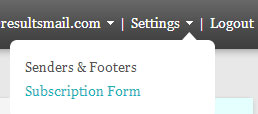How Canada’s new anti-spam law may affect you and what you can do about it.
 Canada has recently introduced a new law that is considered by many to be the most aggressive anti-spam legislation in the world. The Canadian Anti-Spam Legislation (CASL) will go into force on July 1, 2014. ResultsMail’s Email Marketing Service has been helping customers since 2003 with compliance to the U.S. Federal CAN-SPAM act. Canada’s CASL law, however, is a bit different.
Canada has recently introduced a new law that is considered by many to be the most aggressive anti-spam legislation in the world. The Canadian Anti-Spam Legislation (CASL) will go into force on July 1, 2014. ResultsMail’s Email Marketing Service has been helping customers since 2003 with compliance to the U.S. Federal CAN-SPAM act. Canada’s CASL law, however, is a bit different.
What makes CASL different than CAN-SPAM? Opt-In vs. Opt-Out Email Lists
The most important difference between the two is that CAN-SPAM is an Opt-Out law, while CASL is an Opt-In law. To be compliant with CAN-SPAM only requires that you do not falsely identify yourself as the sender, that you include details as to how you may be contacted to be removed from an email list, that the subject line is not deceptive, and that you include an Opt-Out mechanism that recipients may use to be removed from your email list. CASL, on the other hand, requires that you also obtain Express consent prior to sending Commercial Electronic Messages (CEM).
What is the difference between Implied and Express consent?
CASL uses these two terms to qualify a recipient’s consent to receive email messages.
Implied consent is when there is an existing business or non-business relationship between the sender and recipient, but that the recipient has not explicitly asked to receive emails from the sender.
Some examples of Implied consent would be:
- The recipient has purchased something from you in the last 24 months or made an inquiry into your company’s products/services in the last 6 months
- The recipient downloaded a trial or free version of your software
- The recipient has given you their business card with their email address on it
- The recipient’s email address is published on a website, public directory, etc.
- The recipient filled out a form that included a pre-checked box to join your newsletter
This last point is of particular interest. In CAN-SPAM you can have a pre-checked checkbox, whereas with CASL it must be unchecked so that the recipient has to take the specific action of checking the box to Opt-In to receive email.
Express consent is when you directly, clearly and explicitly ask for the recipient’s permission to send them email messages and they clearly agree to the request.
Some examples of Express consent would be:
- The recipient filled out a subscription form on your website that clearly states they will receive emails from you
- The recipient clicked on a link to confirm subscription in a confirmation email
- The recipient clicked an unchecked box on a form to elect to subscribe to your newsletters
- The recipient filled out a form for one organization that included a statement that they would be contacted by third parties. In this case, the original organization must be able to withdraw this consent upon request.
This last point is of special importance to those who may have acquired email lists through trade shows, organizations or associations. A common practice is to include a checkbox on one organization’s form that provides consent to receive messages from other unknown but related third part senders. Under CASL, consent to receive third party email messages is only valid if the recipient can contact the original organization to be removed from the other third party email lists.
I don’t have a business in Canada, will this affect me?
CASL covers any Commercial Electronic Messages sent or accessed by a computer system in Canada. Regardless of where you are located, if you send Commercial Electronic Messages to recipients in Canada, they must be in compliance with CASL. Make sure to review your email list for Canadian email addresses!
What about the transition period?
Canada has given everyone a little bit of time to transition from implied to express consent. Consent to send Commercial Electronic Messages is implied for a period of 36 months beginning July 1, 2014, where there is an existing business or non-business relationship that includes the communication of Commercial Electronic Messages.
During the transitional period, the definitions of existing business and non-business relationships are not subject to the limitation periods of 2 years or 6 months. Businesses and people may take advantage of this transitional period to seek express consent for the continued sending of Commercial Electronic Messages.
What can I do to bring my email list into compliance?
Like CAN-SPAM, CASL requires that you include the following in your email messages:
- Clear identification of the sender
- The sender’s valid postal mailing address (it must remain valid for at least 60 days after the mailing)
- A clear and conspicuous unsubscribe link.
ResultsMail includes your mailing address and an unsubscribe link in the footer of every email you send. The latest update to ResultsMail also makes it possible for you to link different mailing addresses to different sender email addresses. This further aids your compliance as the recipient will know exactly where the email message came from.
ResultsMail also requires that all customers send only to email lists that have explicitly opted in to receive your email, so compliance with this should be no big change. Where the change comes in stands with what proof you have of the original Opt-In request. If you would like to make sure that you have proof, you may consider sending an email to the Canadian email addresses on your email list to ask them to confirm their permission. With ResultsMail you can do that in one of two ways:
- Add a link to your email and save the responses.This can be as simple as adding a big button to an email that says “We would like to make sure you still are enjoying our email newsletters and wish to continue receiving them. Please click here to confirm your subscription to our email list.”If you put up a page on your website that says “Thank you for your confirmation,” you can link to that from the newsletter. When the recipient clicks on the link they will then be directed to your website to see the “Thank you” message.In ResultsMail, the reports will show you who has clicked on that link. You may then export these to Excel for your internal records.
If you later want to make absolutely sure that you are only emailing to the email addresses that clicked on that link, just import that spreadsheet back into a new email list in ResultsMail.You will then have a separate email list of explicitly confirmed subscribers that you may send to in compliance with the new CASL legislation.
 Set up a subscriber form on your website.If you do not already have one set up, now is a great time to start. To do this, follows these steps:
Set up a subscriber form on your website.If you do not already have one set up, now is a great time to start. To do this, follows these steps:
- In ResultsMail click on Settings in the top right corner.
- Select Subscription form. Here you will find the code you can place in your website to set up an email list subscription form.
- Create a new email list just for capturing these addresses. You could name it “Canadian Opt-Ins” for example.
- Then, in the form add <input type=”hidden” name=”group” value=”Canadian Opt-Ins”> to force all subscribers to be added to that email list.
- Once you have this form set up, ResultsMail will log the date and time the address was added to your email list. You may export this data to Excel at any time.
As always, if you need any assistance or have more questions, please ask us. We’re more than happy to help!
Please note we are not lawyers and the information provided here cannot be considered legal advice, nor is it legally binding. For specific questions we advise you to contact an attorney.
For additional details please see:
Frequently Asked Questions about Canada’s Anti-Spam Legislation

2 Comments